Harnessing Black Soldier Fly Larvae for Sustainable Biofuel Production: A Review of Global Research Trends and Future Directions
Abstract
The growing global demand for sustainable energy and effective waste management solutions has increased interest in innovative biofuel production methods. This study analyzes global research trends in utilizing black soldier fly (BSF) larvae in biofuel production from 2010 to 2023. A comprehensive bibliometric analysis was conducted using the Scopus database and the Bibliometrix R package. The study revealed a significant publication increase, with an annual growth rate of 23.83%. China and Malaysia emerged as leading research hubs, contributing 263 and 178 publications, respectively. Keyword analysis demonstrated a shift from broad exploration to focused studies on biodiesel production, waste management, and circular economy principles. The research field showed a multidisciplinary approach, integrating entomology, biotechnology, and energy engineering. Recent advances highlighted BSF larvae’s efficiency in converting various organic wastes into high-quality biodiesel and biogas, with promising results in optimizing production processes and enhancing fuel properties. However, challenges persist in scaling up production and ensuring biological consistency. These findings highlight the potential of BSF larvae as a sustainable solution for simultaneous waste valorization and biofuel production, contributing to global efforts in renewable energy and circular economy practices.
1. Introduction
Energy consumption is essential for developing socioeconomic sectors [1, 2]. Around 85% of the world’s energy production and consumption comes from fossil fuels, such as natural gas, coal, and oil [3]. However, with rising concerns about climate change and global warming, selecting sustainable energy supply options has become a global priority. This necessitates a shift from fossil fuels to low-carbon energy sources, including renewable energy sources (solar, wind, biofuels, hydropower, and geothermal) [4], nuclear power [5] and green hydrogen [6]. Such a transition is crucial for meeting emissions reduction targets outlined in international agreements like the Paris Climate Agreement [7].
Moreover, reliance on fossil fuels threatens energy security and macroeconomic stability due to price volatility [8, 9]. The world’s energy consumption is projected to increase by nearly 50% between 2020 and 2050, driven by population growth, economic expansion, and technological advancements [10]. This expected surge in energy demand and the urgent need to mitigate climate change have catalyzed a global shift toward green and renewable energy solutions [11, 12]. Among these, biofuels are emerging as a key component of the renewable energy sector, providing a promising avenue for reducing dependence on fossil fuels [13, 14] while tackling pressing environmental challenges [15–17].
In this context, the black soldier fly (BSF) larvae (Hermetia illucens) have gained attention for their potential in biofuel production. This innovative approach intersects waste management [18, 19], sustainable energy generation [20, 21], and circular economy principles [22, 23]. The BSF larvae can efficiently derive nutrients from low-cost resources, including municipal waste (household, restaurant, and food industry waste) and animal manure from chickens, cows, and sheep [24]. As waste management crises intensify and the demand for biofuels grows, the BSF larvae present a potential approach to addressing these global challenges.
With an estimated 2.01 billion tonnes of municipal solid waste generated annually worldwide and organic waste constituting a significant portion of this volume, innovative waste management strategies are more pressing than ever [25]. BSF larvae have demonstrated remarkable efficacy in bioconverting organic waste into valuable biomass, presenting a dual solution to waste reduction and sustainable resource generation [26–28]. This approach can divert organic waste from landfills. BSF-based systems can significantly reduce methane emissions—a greenhouse gas with 28 times the warming potential of carbon dioxide (CO2) over 100 years [29]. BSF larvae primarily produce CO2 through respiration and metabolic activities. The average emission during the rearing process is estimated to be between 1 and 4 kg CO2 equivalent per kg of dry BSF biomass [30]. This emission is considerably lower than that from traditional composting methods, where CO2 emissions can be significantly higher due to aerobic decomposition processes [31].
Furthermore, using BSF larvae in biofuel production aligns with circular economy principles, transforming what was once considered waste into a valuable energy resource, thereby closing the loop in resource utilization and minimizing environmental impact [32, 33]. The bioconversion efficiency of BSF larvae stands as a cornerstone of their potential in biofuel production [34, 35]. These remarkable organisms exhibit several key characteristics that make them ideal candidates for organic waste valorization and subsequent biofuel generation. First, BSF larvae boast an impressive growth rate, capable of increasing their body mass by up to 45% per day under optimal conditions [36]. This rapid growth is complemented by their voracious appetite and ability to consume various organic substrates, including food waste, agricultural byproducts, and even certain types of manure [37].
Perhaps most crucial for biofuel applications, BSF larvae accumulate significant lipid content throughout their development, with some studies reporting lipid contents of up to 30%–35% on a dry matter basis [38]. This high lipid content, primarily composed of medium-chain fatty acids, makes BSF larvae an excellent feedstock for biodiesel production. Moreover, the protein-rich fractions of the larvae can be utilized for other valuable products, such as animal feed or bioplastics, further enhancing the economic viability of BSF-based biofuel systems. The economic prospects of utilizing BSF larvae in biofuel production have attracted significant attention from the scientific community and industry stakeholders. The cost-effectiveness of BSF-based systems stems from several factors, including the low input costs associated with organic waste feedstocks, the rapid biomass accumulation of the larvae, and the potential for multiple value streams from a single production cycle [39, 40]. A life cycle assessment conducted by Salomone et al. [41] BSF-based biodiesel production could achieve a positive energy balance and lower environmental impacts than conventional biodiesel feedstocks.
The potential of BSF-based biofuel production takes on particular significance in the context of the Global South, where issues of waste management, energy access, and rural development intersect. In many developing countries, inadequate waste management infrastructure and limited access to modern energy services present significant challenges to sustainable development [42, 43]. In view of this, BSF-based systems offer a promising solution by providing a decentralized approach to waste treatment and energy production. This aligns closely with circular economy principles and has the potential to foster rural development by creating new economic opportunities in waste valorization and biofuel production [44]. However, BSF farming may lead to competition for organic waste resources, prioritizing specific substrates and neglecting others [28, 45]. Also, resource pressures could worsen with nutrient-rich substrates. The introduction of BSF farming can raise biosecurity concerns. Farming insects like BSF can inadvertently facilitate the spread of pests and pathogens if not appropriately managed. For example, if larvae are fed contaminated organic waste, there is a risk of disease transmission to livestock or humans through the food chain [28]. Furthermore, the large-scale cultivation of BSF could lead to the establishment of feral populations that might compete with native insect species or disrupt local ecosystems.
Beyond technological advancements, policy frameworks are pivotal in accelerating the adoption of BSF larvae-based biofuel production. For instance, effective policies integrating waste management regulations, clean energy incentives, and agricultural standards can create a conducive ecosystem for BSF bioconversion. Governments could implement tiered regulatory approaches that simplify compliance for small-scale BSF operations while maintaining rigorous standards for industrial-scale facilities. In addition, carbon credits serve as a market-driven mechanism for cutting greenhouse gas emissions [17]. This implies that biofuel producers utilizing BSF larvae may qualify for carbon credits by reducing methane emissions through organic waste diversion from landfills and replacing carbon-intensive feedstocks. Likewise, financial mechanisms such as tax incentives, subsidies for organic waste diversion, and preferential loan terms could catalyze private sector investment, particularly in Global South contexts where waste management infrastructure is limited [46]. Additionally, standardization of BSF larvae quality metrics and processing protocols would build market confidence and facilitate international trade of BSF-derived biofuels. Furthermore, policy harmonization across national and regional boundaries would prevent regulatory arbitrage while promoting knowledge transfer and technology diffusion [47].
Several researchers have reviewed BSF larvae’s progress in different application domains. For instance, Mangindaan et al. [24] bibliometrically analyzed the utilization of BSF larvae for biodiesel preparation, organic waste treatment, and alternative feed generation, aiming to address the waste-food-energy nexus over the past decade (2011–2022). Čičková et al. [48] reviewed the use of fly larvae, particularly house flies and black soldier flies, for the biodegradation of organic waste and explored their potential for producing valuable byproducts such as animal feed, biodiesel, and fertilizer. Raksasat et al. [27] comprehensively reviewed the potential of BSF Larvae in valorizing organic wastes through an entomoremediation approach. Mohan et al. [49] reviewed recent advancements and challenges in using BSF larvae as a potential feedstock for biodiesel production. Surendra et al. [50] critically assessed the current status of BSF technology, identified research gaps, and highlighted challenges in scaling up industrial production and processing of BSF biomass. Kim et al. [51] explored BSF larvae’s research trends and potential in treating organic waste, particularly food waste, in Asian countries. The authors focused on BSF larvae’s bioconversion efficiencies, the optimal conditions for waste treatment operations, and their applications as biofuel and animal feed.
The reviews above have significantly contributed to the field, yet critical research gaps remain. For instance, Mangindaan et al. [24] focused solely on biodiesel, whereas this review broadened the scope to include biogas and bioethanol. Čičková et al. [48] examined organic waste biodegradation but lacked a bibliometric perspective, which this study integrates to identify global research trends and collaborations. Similarly, Raksasat et al. [27] emphasized entomoremediation but overlooked scalability challenges and emerging biofuel production methods, which are central to this review. This study bridges these gaps by combining bibliometric and systematic review approaches. Bibliometrics, as a quantitative tool, reveals research evolution, key contributors, collaborations, and emerging trends [52–56], providing critical insights beyond traditional reviews. This study identifies key trends, challenges, research gaps, and opportunities within the broader sustainable energy and waste management framework by critically analyzing BSF larvae in biofuel production. It provides a roadmap for future research and implementation, offering evidence-based recommendations for policymakers, industry stakeholders, and researchers.
The remainder of the paper is organized as follows: Section 2 provides a summary of BSF larvae cultivation as well as its conversion to obtain different biofuels; Section 3 outlines the methodological approach adopted; Section 4 presents the results and discusses their implications; Section 5 summarizes the findings and offers perspectives for future research in the field; Section 6 concludes the study; and Section 7 highlights the study limitations for future research.
2. Overview of BSF Larvae Cultivation
BSF larvae, scientifically known as H. illucens, are increasingly recognized for their rapid growth and ability to convert organic waste into valuable biomass [57]. Figure 1a shows black soldier flies in a cultivation chamber. The complete life cycle of the BSF, shown in Figure 1b, depicts five distinct developmental stages in a circular process. The cycle begins with the adult fly, which has a lifespan of 5–8 days and is responsible for mating and egg-laying; the cycle progresses to the egg stage, where 500–900 eggs are laid with a 4-day hatch time. The larvae then emerge and go through five instars over 13–18 days, feeding on household and industrial waste. Following the larval stage, the organism enters the prepupal stage, lasting 7–10 days, as a 6th instar that does not feed. The final transformation before adulthood occurs in the pupal stage, which requires a minimum of 8 days without feeding.
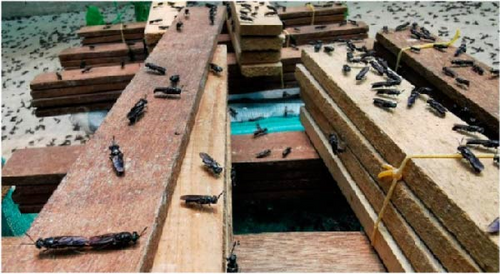
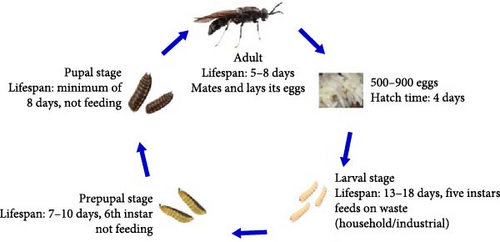
BSF cultivation typically occurs in controlled environments that optimize temperature and humidity, which are essential for maximizing larval growth. For instance, a modular fly hive measuring 100 × 100 × 25 cm is often used, with conditions maintained around 27–29°C and humidity levels between 63% and 75% [58]. The cultivation process begins with hatching BSF eggs in a nutrient-rich medium, including a bran and warm water mix. After about 7 days, the larvae are transferred to a substrate composed of organic waste materials such as chicken manure, vegetable scraps, and fruit waste. The larvae then undergo a growth phase lasting ~21 days before they are harvested [59]. BSF larvae are particularly valued for their high protein content, making them an excellent feed source for livestock. Their ability to thrive on organic waste not only reduces disposal costs but also contributes to sustainable farming practices by recycling nutrients back into the agricultural system [60].
The conversion of BSF larvae into biofuels primarily involves extracting lipids from the larvae, which can then be transformed into biodiesel. Studies indicate that BSF larvae can contain up to 70% extractable oil, rich in saturated and unsaturated fatty acids. This oil can be processed through transesterification, a chemical reaction that converts fats into biodiesel [49, 61]. The predominant biofuel produced from BSF larvae is biodiesel, which has been shown to yield high production rates with lower energy inputs than traditional biodiesel sources [61, 62]. In addition to biodiesel, BSF larvae can contribute to biogas production in anaerobic digestion processes, further enhancing their utility in waste management and energy generation [63].
3. Methodology
Figure 2 displays the detailed approach adopted to address the study goal. The Preferred Reporting Items for Systematic Reviews and Meta-Analyses (PRISMA) guidelines were methodically followed to ensure a systematic and transparent approach to data extraction and analysis [64–67]. The Scopus database was selected as the primary source for data collection due to its extensive coverage of peer-reviewed literature, rigorous indexing practices, and comprehensive metadata, which are crucial for conducting a thorough bibliometric analysis [68–70]. Scopus was chosen over Web of Science for its broader journal coverage, particularly in environmental science and biotechnology, and over Google Scholar due to its more structured and verified dataset, which is essential for maintaining the integrity of bibliometric analyses.
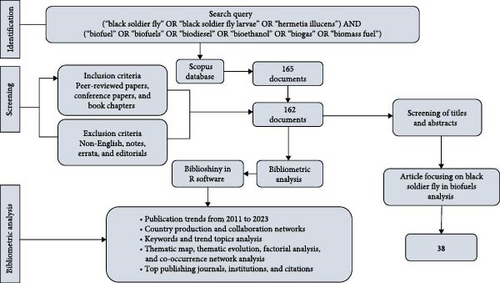
The search query was carefully constructed to comprise all relevant literature, utilizing the following terms: (“black soldier fly” OR “black soldier fly larvae” OR “hermetia illucens”) AND (“biofuel” OR “biofuels” OR “biodiesel” OR “bioethanol” OR “biogas” OR “biomass fuel”). This comprehensive query ensured the capture of all pertinent studies within the scope of the research. The inclusion criteria were deliberately broad to capture various scholarly outputs, comprising peer-reviewed papers, conference papers, review papers, and book chapters. Conversely, the exclusion criteria were designed to filter out non-peer-reviewed or less substantial contributions, such as notes, errata, and editorials, ensuring the analysis focused on substantive research outputs. The search period was defined as 2010–2023, providing a decade window to observe long-term trends and developments in the field. Initially, the search yielded 165 papers, subsequently refined to 163 after applying the inclusion and exclusion criteria. A final filter for English-language publications resulted in a dataset of 162 papers, forming the basis for the bibliometric analysis. Data extraction was performed on September 14, 2024, to provide a current view of the research area.
The Bibliometrix package within R software, facilitated by the Biblioshiny library, was employed to conduct several bibliometric analyses [71]. Bibliometrix provides comprehensive science mapping capabilities, including functions for importing bibliographic data from major databases like Web of Science and Scopus, performing various analyses, and visualizing results [72, 73]. Biblioshiny, on the other hand, is a web-based interface for Bibliometrix, providing a user-friendly GUI that allows researchers to conduct bibliometric analyses without writing R code [74, 75]. Both tools enable users to perform descriptive analysis of bibliographic data, assess author and document impact, analyze cocitation and collaboration networks, explore conceptual structures through coword networks, and identify emerging trends in scientific literature. These versatile instruments have become essential for academics conducting literature reviews, evaluating research performance, and gaining insights into the structure and dynamics of scientific fields.
We performed the following bibliometric analyses: (i) publication trends were scrutinized to identify patterns in research output over time; (ii) country production and collaborations were mapped to understand the global distribution of research efforts and international partnerships; (iii) keyword and trend topic analyses were performed to identify emerging themes and shifts in research focus; (iv) thematic mapping and evolution were explored to visualize the development of key research areas over the study period; (v) factorial analysis was conducted to uncover underlying patterns and relationships in the dataset; (vi) co-occurrence network analysis of keywords was utilized to reveal interconnections between research topics and identify potential research clusters; and (vii) analyses of top publishing journals, institutions, and citations were carried out to identify influential actors and publications in the field.
Furthermore, we systematically reviewed the most relevant papers on BSF-based biofuels to complement the quantitative bibliometric analysis. This qualitative component allowed for a deeper exploration of significant findings, methodological approaches, and theoretical developments in BSF larvae utilization in biofuel production. It is worth mentioning that combining comprehensive bibliometric analysis with the systematic review of key literature ensures a holistic understanding of the research field, providing broad trends and detailed insights into the most impactful research contributions. This methodological approach quantifies the research state and offers critical qualitative insights, providing a robust foundation for identifying research gaps, emerging trends, and potential future directions in BSF larvae-based biofuel production.
4. Results and Discussion
The study findings and their implications are presented in this section.
4.1. Overview of Bibliometric Data
Figure 3 summarizes the bibliometric data from 2011 to 2023. The field has shown significant growth and interest over this 12-year timespan, as evidenced by the high annual growth rate of 23.83% in publications. A total of 162 documents have been produced from 84 different sources, indicating a diverse range of research outlets contributing to this area. The involvement of 655 authors, with an average of 5.85 coauthors per document, suggests a collaborative approach to research in this field. Notably, only three authors have produced single-authored papers, further emphasizing the collaborative nature of this research. The international scope of the research is highlighted by the 35.8% rate of international coauthorship, demonstrating global interest and cooperation in exploring the potential of BSF larvae in biofuel production. The presence of 389 author keywords (DE) indicates a rich and varied vocabulary surrounding this research topic, pointing to its complex nature and the diverse aspects being explored. The substantial number of references (8180) used across these publications suggests a thorough grounding in existing literature and a building upon previous knowledge. The relatively young average age of documents (3.86 years) implies that much of the research is recent, indicating the cutting-edge nature of this field. Perhaps most strikingly, the average of 52.4 citations per document suggests that the research has a significant impact and is widely read and referenced within the scientific community. This high citation rate, combined with the rapid growth in publications, suggests that using BSF larvae in biofuel production is a hot topic in sustainable energy research, with potential implications for addressing global energy challenges and promoting circular economy principles in waste management and energy production.

4.2. Total Annual Publications, Country Production, and Collaborations
Figure 4 shows a significant trend in the research focus over the past decade. Starting from a modest number of publications in 2011 and 2012, with only two articles each year, there was a brief lull in 2013 with no publications, followed by a slight resurgence in 2014 with a single article. However, from 2015 onwards, there has been a marked and consistent increase in research output on this topic. The year 2015 saw four articles published, which more than doubled to eight by 2017. A substantial leap occurred in 2018, with 16 articles published suggesting growing interest in the field. This upward trajectory continued, reaching a peak of 33 articles in 2022, representing a more than 16-fold increase from the initial years. The years 2020 and 2021 also saw significant output with 26 and 24 articles, respectively, despite potential research disruptions due to the global pandemic. The slight decrease to 26 articles in 2023 may indicate a stabilization of research interest or be attributed to factors such as publication cycles or shifts in funding priorities. This overall trend implies a growing recognition of the potential of BSF larvae in biofuel production, likely driven by increasing global emphasis on sustainable energy sources and waste management solutions. The consistent rise in publications suggests that researchers find promising results, leading to expanded studies and applications. This surge in research output could have significant implications for the biofuel industry, potentially providing a more sustainable and efficient method of producing renewable energy. Additionally, it may contribute to addressing waste management issues, as BSF larvae are known for their ability to process organic waste. The sustained research interest over the years indicates that this field is moving beyond initial exploratory stages and may be approaching practical applications or commercialization phases.
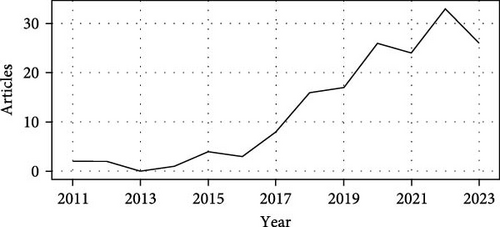
Figure 5 shows a significant disparity in research output across different countries. It can be seen that China has the highest total publications of 263 articles, substantially outpacing other nations. This dominance suggests that China has prioritized this area of research, possibly due to its pressing need for sustainable energy solutions and waste management strategies in the face of rapid industrialization and urbanization. Malaysia follows with 178 publications, indicating a robust research focus in Southeast Asia. Italy is the leading European contributor with 96 publications, potentially indicating the European Union’s emphasis on circular economy principles and sustainable biotechnologies. The United States, despite its typically strong research output in many scientific fields, ranks fourth with 38 publications, suggesting that this specific area of biofuel research might not be as prioritized compared to other regions. The presence of developing nations like Indonesia, India, Kenya, and South Africa in the top ranks highlights the global relevance of this research, particularly in regions facing significant waste management challenges and seeking sustainable development solutions.
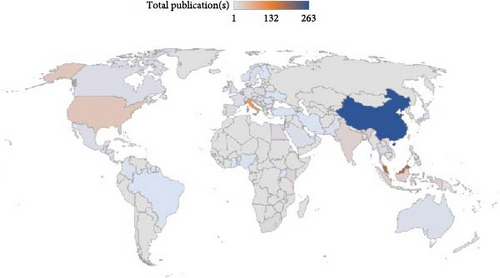
The wide geographic distribution of research across Europe, Asia, North America, Africa, and Oceania indicates a global recognition of the potential of BSF larvae in biofuel production. However, the stark differences in publication frequency highlight potential disparities in research funding, infrastructure, and policy priorities across nations. This global research sector implies that knowledge transfer and international collaboration are vital in advancing this field, as countries with fewer publications could benefit from the experiences and findings of the leading nations. Furthermore, the varied levels of research engagement across countries might lead to differences in the pace of practical implementation and policy development regarding this biotechnology, potentially creating challenges and opportunities for global cooperation in sustainable energy and waste management solutions. BSF larvae-based biofuel research holds immense potential for regions like Africa, where waste management infrastructure is underdeveloped. Decentralized BSF systems can convert indigenous waste streams into valuable biofuels, addressing energy poverty while supporting rural economic development. Expanding research and knowledge-sharing initiatives in these regions could unlock untapped opportunities for sustainable development.
The European Union’s Renewable Energy Directive (RED II) represents a comprehensive framework for promoting renewable energy adoption across member states. This directive sets binding targets for renewable energy usage and includes specific provisions for biofuel development [76]. Although the current framework primarily focuses on traditional biofuel sources, expanding it to include insect-based alternatives explicitly would create significant market opportunities for BSF larvae-derived biofuels. China’s Circular Economy Promotion Law demonstrates another approach to supporting sustainable technologies [77]. This legislation emphasizes resource efficiency and waste reduction, creating favorable conditions for BSF implementation since these insects can process organic waste into valuable biofuel feedstock. The law’s framework could be enhanced to recognize and incentivize insect-based biotechnology. These policy frameworks could be strengthened in several ways to bridge the research-implementation gap. First, they could introduce specific incentives for companies investing in BSF biofuel production, such as tax benefits or subsidies. Second, they could establish regulatory standards for insect-based biofuel quality and production processes. Third, they could create mechanisms for public–private partnerships to scale up promising BSF technologies. Real-world examples demonstrate the impact of supportive policies. Therefore, expanding these frameworks would accelerate BSF commercialization by providing regulatory certainty, financial incentives, and market access for innovative companies in this space.
Figure 6 displays the countries’ collaboration map. This map visually represents international cooperation in BSF larvae-based biofuel research. The map reveals a complex network of collaborations covering multiple continents, with varying degrees of intensity indicated by the color shading of countries and the connecting lines between them. China stands out prominently as a dark blue hub, suggesting it is a central player in this research field, likely due to its high number of publications and collaborations. The map shows strong connections between China and several other countries, particularly in North America and Europe, as evidenced by the thicker lines. This indicates substantial collaborative efforts between Chinese researchers and their international counterparts. The United States and several European countries are colored in lighter blue, implying significant but perhaps less dominant roles in the research landscape than China.
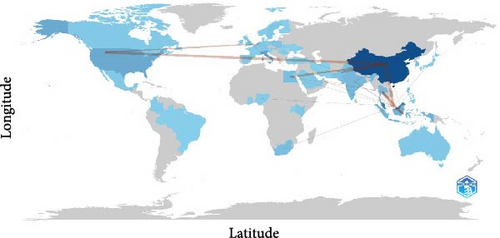
It can be observed that visible collaborations between North America, Europe, and Asia form a triangular knowledge exchange network. Some African and South American countries are also represented in light blue, indicating their involvement in the field, although potentially to a lesser extent. Connections to these regions suggest a growing global interest in this sustainable biofuel technology, with knowledge transfer occurring across diverse geographical and economic contexts. Australia’s light blue indicates its participation in this research area, with visible connections to other countries, highlighting its engagement in international collaborations. The map also hints at the potential for further expansion of collaborations, particularly in regions currently shown in gray, such as large parts of Africa and South America. This global collaboration network has significant implications for advancing BSF larvae research in biofuel production. It suggests a concerted international effort to develop this technology, potentially accelerating progress through shared knowledge and resources. The strong involvement of China might lead to faster developments and implementations in this field, while the broad international participation ensures diverse perspectives and applications suited to various local contexts. However, the apparent concentration of research in certain regions also highlights the need for more inclusive global participation to address region-specific challenges and opportunities in biofuel production using this method.
4.3. Keywords and Trend Topics Analyses
Figure 7 shows the word cloud of author keywords. It can be observed that the most prominent terms in the cloud are “black soldier fly,” “biodiesel,” and “hermetia illucens,” which clearly define the core focus of this research field. The prominence of “biodiesel” suggests this is likely the primary biofuel product being investigated. Other significant terms like “bioconversion,” “biofuel,” and “circular economy” indicate that this research is firmly situated within the broader context of sustainable energy production and waste management strategies. The presence of “food waste,” “organic waste,” and “waste management” highlights the dual benefit of this technology in addressing both energy production and waste reduction challenges.
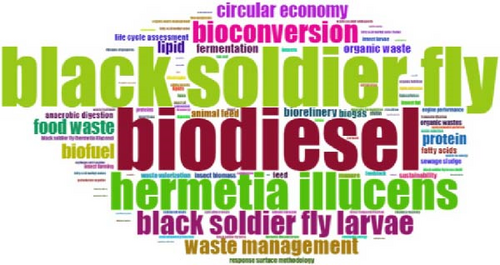
Terms such as “lipid,” “protein,” and “fatty acids” point to the biochemical aspects of the research, likely focusing on the composition of the larvae and their potential as a feedstock in biofuel production. “Fermentation” and “anaerobic digestion” suggest different processing methods being explored to convert the larvae into usable biofuel. Including “life cycle assessment” implies that researchers are considering this biofuel production method’s overall environmental impact and sustainability. “Animal feed” indicates a potential secondary application of the process, where byproducts or processed larvae could be used in agriculture. The presence of “biorefinery” suggests a more comprehensive approach to utilizing the larvae, potentially extracting multiple valuable products beyond biofuel. Terms like “sustainability,” “valorization,” and “resource recovery” further emphasize the environmental and economic drivers behind this research. The word cloud also reveals connections to broader environmental concepts through terms like “greenhouse gas emissions” and “climate change,” indicating that the research is being conducted considering global environmental challenges. The diversity of terms in the word cloud implies that the research on using BSF larvae in biofuel production is complex, involving various scientific disciplines and addressing multiple aspects of sustainability and circular economy principles. This interdisciplinary approach suggests that the field is evolving to consider the technical feasibility of biofuel production and its broader implications and potential for integration into sustainable waste management and energy systems.
The trend topics in Figure 8 provide a comprehensive overview of the evolution and current focus areas from 2018 to 2022. This visualization indicates several key insights into the field’s development and shifting priorities over time. Notably, terms like “black soldier fly,” “hermetia illucens,” and “biodiesel” have been consistently prominent throughout the entire period, indicating their central role in this research area. The persistent focus on these terms emphasizes the sustained interest in utilizing this species for biodiesel production. Interestingly, “food waste” and “black soldier fly larvae” show a strong presence toward the end of the timeline, suggesting a recent increased emphasis on the waste management aspect of this technology. This shift could imply a growing recognition of this approach’s dual benefits in addressing energy production and waste reduction challenges. The term “life cycle assessment” appears to have gained significant attention in the most recent year, indicating a move toward more holistic evaluations of this biofuel production method’s environmental impacts and sustainability. This trend aligns with the global emphasis on comprehensive sustainability assessments in renewable energy technologies. “Waste management” and “circular economy” show consistent presence over the years, reinforcing that this research is deeply embedded in broader sustainability and resource efficiency frameworks. The appearance of “biorefinery” midway through the timeline and its continuation to the present suggests an evolution toward more integrated and multiproduct approaches to utilizing BSF larvae. “Anaerobic digestion” emerges as a topic of interest toward the end of the period, potentially indicating the exploration of alternative or complementary processing methods. “Biofuel” maintains a steady presence, underlining the consistent focus on energy production applications. The emergence and growth of topics like “circular economy” and “life cycle assessment” in recent years imply that the research is expanding beyond purely technical aspects to include broader environmental and economic considerations. This evolution suggests a maturing field increasingly considering the technology’s practical implementation and wider implications. The trend topics reveal a dynamic and evolving research area, with a consistent core focus on BSF larvae for biodiesel production, but with growing attention to waste management, sustainability assessment, and circular economy principles. This trend indicates that the field is moving toward more comprehensive and integrated approaches to biofuel production using BSF larvae, potentially enhancing its viability and relevance in addressing contemporary environmental challenges.
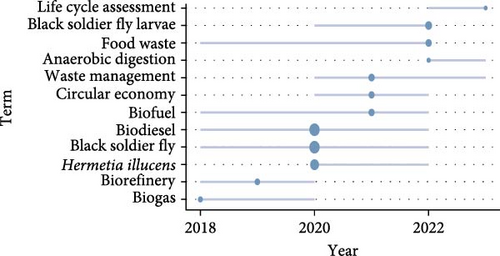
4.4. Co-Occurrence Network Analysis
Figure 9 presents the co-occurrence network analysis of keywords. This analysis provides a comprehensive overview of the interconnected research themes and concepts surrounding using BSF larvae in biofuel production. At the center of the network, we see “biodiesel” as the largest node, indicating its central role as the primary focus of this research field. Closely connected to it are “hermetia illucens” and “black soldier fly larvae,” reinforcing the specific species at the core of this biofuel production method. The network reveals several clusters of related concepts, each representing different aspects of the research area.
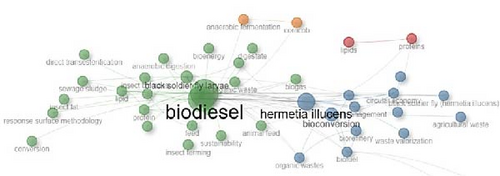
One cluster, predominantly in green, includes terms like “lipid,” “protein,” “feed,” and “insect farming,” suggesting a focus on the biochemical composition of the larvae and their potential as a feedstock not just for biofuel but also for animal nutrition. This implies a holistic approach to utilizing the larvae, maximizing their value across multiple applications. Another cluster, shown in blue, comprises terms such as “waste management,” “circular economy,” “bioconversion,” and “agricultural waste,” highlighting the environmental and sustainability aspects of this technology. This cluster highlights BSF larvae’s potential to simultaneously address waste reduction and renewable energy production, aligning with circular economy principles. The presence of terms like “anaerobic digestion,” “anaerobic fermentation,” and “biogas” in orange nodes indicates exploration of various processing methods and potential byproducts of the biofuel production process. This suggests ongoing research into optimizing the conversion of larvae into usable energy forms. Including “life cycle assessment” in the network implies a growing emphasis on evaluating this biofuel production method’s overall environmental impact and sustainability throughout its entire lifecycle.
Terms such as “bioenergy,” “biorefinery,” and “waste valorization” further emphasize the complex approach to extracting value from the larvae and associated waste streams. The network also reveals connections to broader environmental and agricultural concepts through terms like “greenhouse gas emissions,” “sustainability,” and “organic waste,” indicating that the research is being conducted with global environmental challenges and agricultural sustainability in mind. The presence of “direct transesterification” suggests exploring specific chemical processes for efficient biodiesel production. The co-occurrence of “compost” with other waste management terms implies that researchers are considering the potential of byproducts or residues from the biofuel production process for soil amendment applications.
The network’s structure, with its interconnected nodes and clusters, highlights the interdisciplinary nature of this research field. It suggests that advancements in using BSF larvae in biofuel production will likely come from integrating knowledge across various domains, including biochemistry, waste management, agricultural science, and environmental studies. This interdisciplinary approach could lead to more innovative and sustainable solutions for biofuel production. The implications of this co-occurrence network are significant. It suggests that research in this field is not solely focused on the technical aspects of biodiesel production but is evolving to address broader sustainability challenges. The integration of waste management and circular economy principles indicates the potential for this technology to contribute to multiple sustainable development goals simultaneously. Furthermore, the diverse range of connected concepts implies that advancements in this field could have far-reaching impacts across various sectors, from agriculture and waste management to renewable energy and environmental conservation. As research progresses, we might expect to see more integrated solutions that optimize the use of BSF larvae across multiple applications, potentially revolutionizing approaches to sustainable resource management and biofuel production.
4.5. Thematic Mapping
The thematic map of keywords in Figure 10 provides a holistic overview of the research field, categorizing themes based on their development degree (density) and relevance degree (centrality). In the motor themes quadrant, which represents highly developed and central topics, we find key terms such as “biodiesel,” “black soldier fly,” and “bioconversion.” This positioning indicates that these concepts are at the core of the research field, driving its progress and serving as fundamental pillars. The presence of “engine performance,” “combustion,” and “exhaust emission” in this quadrant suggests a strong focus on the practical applications and performance aspects of the biofuel produced. Additionally, including “renewable energy” and “waste-to-energy” highlights the field’s alignment with broader sustainable energy goals.
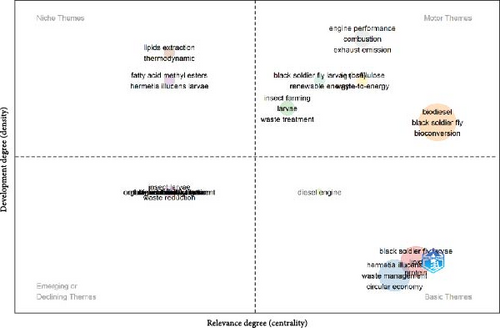
The basic themes quadrant, characterized by high centrality but lower density, includes important foundational concepts like “black soldier fly larvae,” “hermetia illucens,” “waste management,” and “circular economy.” This placement implies that while these themes are crucial to the field, there may be room for further development and intensification of research in these areas. The presence of “protein” in this quadrant also suggests an emerging interest in the nutritional aspects of the larvae, potentially opening up parallel research streams. In the niche themes quadrant, which represents highly developed but less central topics, we find more specialized research areas such as “lipids extraction,” “thermodynamic,” and “fatty acid methyl esters.” In contrast, these well-developed themes may interest a smaller subset of researchers or represent more focused, technical aspects of the field. The presence of “hermetia illucens larvae” in this quadrant, separate from the more general “black soldier fly larvae” in the basic themes, might indicate a more specialized focus on the larval stage, specifically for biofuel production.
The emerging or declining themes quadrant, characterized by both low density and centrality, includes concepts like “organic waste treatment,” “waste reduction,” and “insect larvae.” Their position suggests that these themes may either be new areas of exploration in the context of BSF larvae in biofuel production or potentially declining in relevance. However, given the overall focus of the field, it is more likely that these represent emerging areas that are beginning to gain attention but have not yet become central to the research area.
The implications of this thematic map are significant for BSF larvae-based biofuel production. First, it highlights the multidisciplinary nature of the research, from basic biological understanding of the species to applied engineering in biofuel production and engine performance. The strong presence of waste management and circular economy concepts in the basic themes’ quadrant suggests that researchers increasingly view this technology through broader sustainability frameworks. This could lead to more integrated approaches considering the entire process lifecycle, from waste management to energy production. The positioning of lipid extraction and thermodynamic processes in the niche themes quadrant indicates areas of technical specialization that could be critical for optimizing biofuel production efficiency. As these niche areas develop, they may move toward becoming motor themes, driving innovation in the field. The emergence of protein-related research in the basic themes’ quadrant hints at the potential diversification of applications beyond biofuel, possibly into animal feed or other protein-based products. This could enhance the economic viability of BSF larvae cultivation by creating multiple value streams. This thematic map suggests a maturing field with a solid core of established research areas, complemented by emerging themes that could shape its future direction. The research area appears to be evolving toward more holistic, sustainability-oriented approaches while delving into specialized technical optimizations. This balanced development bodes well for the future of BSF larvae-based biofuel production, suggesting potential for both practical implementation and continued innovation.
4.6. Thematic Evolution
Figure 11 depicts the thematic evolution of keywords from 2011 to 2023. This timeline reveals a dynamic shift in research focus and emerging trends within this field. In the initial period from 2011 to 2019, the primary keywords were “hermetia illucens,” “fermentation,” “biodiesel,” and “black soldier fly larvae,” indicating a broad interest in the potential of these insects for biofuel applications. As we move into 2020–2021, there is a notable concentration on “biodiesel” and “hermetia illucens,” suggesting an intensified focus on the specific use of BSF larvae for biodiesel production. The period of 2022 marks a significant expansion in research themes, introducing new keywords such as “black soldier fly,” “waste management,” and “food waste.” This expansion implies a growing interest in the broader ecological and waste management implications of using BSF larvae, extending beyond biofuel production. Including “waste management” and “food waste” keywords suggests researchers are exploring these larvae’s dual benefits in waste reduction and biofuel generation. The most recent period, 2023, shows a continued focus on “biodiesel” while introducing new concepts like “circular economy,” “life cycle assessment,” and maintaining interest in “hermetia illucens.” This evolution indicates a more holistic research approach, considering not just the end product (biodiesel) but also the entire life cycle and economic model surrounding the use of BSF larvae.

The emergence of “circular economy” as a keyword is particularly significant, as it suggests that researchers are now considering how these larvae used for biofuel production can fit into broader sustainable economic models. The presence of “hermetia illucens” throughout the timeline highlights its central role in this research area. The implications of these results are profound for the future of sustainable energy and waste management. They suggest a growing recognition of BSF larvae as a comprehensive solution to environmental challenges, capable of simultaneously addressing waste management issues, renewable energy production, and sustainable economic practices. The research trajectory indicates a move toward more integrated and systemic approaches, considering the technical aspects of biofuel production and its broader environmental, economic, and lifecycle impacts. This evolution in research focus could lead to more comprehensive and sustainable solutions for biofuel production, potentially revolutionizing how we approach waste management and renewable energy.
4.7. Factorial Analysis
The factorial analysis of keywords is shown in Figure 12. The factorial analysis presented in this conceptual structure map provides a comprehensive overview of the research area. The triangular shape of the map indicates a progression from broad, foundational concepts on the left to more specific, application-oriented topics on the right. On the left side, we see a cluster of keywords related to raw materials and processes, such as “corncob,” “anaerobic fermentation,” “organic wastes,” and “sewage sludge,” suggesting a focus on diverse feedstocks for insect-based biofuel production. The presence of “low cost” and “organic fertilizer” in this area emphasizes economic viability and circular economy principles. Moving toward the center, we find terms like “black soldier fly larva,” “fatty acid methyl ester,” and “direct transesterification,” which represent the core processes and organisms involved in this biofuel production method. The inclusion of “edible insects” and “waste to energy” highlights the complex potential of BSF larvae, not just for biofuel but also for food security and waste management. As we move to the right side of the map, we see more technical and performance-related terms such as “diesel engine,” “engine performance,” and “exhaust emissions,” indicating a focus on the practical application and evaluation of the produced biofuels. The rightmost terms, “combustion” and “insect oil,” represent this research’s goal and product.

The implications of this analysis are significant. It suggests that research in this field is holistic, covering the entire value chain from waste management and insect rearing to biofuel production and engine performance. The prominence of terms related to various organic wastes and low-cost inputs indicates a strong focus on sustainability and resource efficiency. Furthermore, terms like “renewable energy” and “bioenergy” alongside more specific processes suggest that researchers are positioning insect-based biofuels within the broader context of sustainable energy solutions. The analysis also implies a growing body of research on the technical aspects of using these biofuels in real-world applications, as evidenced by the engine and emissions-related terms. This comprehensive approach could lead to more integrated and efficient systems for waste management and renewable energy production, potentially offering solutions to multiple environmental challenges simultaneously.
4.8. Top Publishing Journals, Institutions, and Most Cited Countries
The journals with the highest publications are displayed in Figure 13. Renewable Energy Journal leads with 11 articles, followed by the Journal of Cleaner Production and Waste Management, each with eight publications. This distribution suggests that the research primarily focuses on sustainable energy solutions and waste management applications. The presence of journals like the Journal of Environmental Management, Sustainability, and Energy Conversion and Management further reinforces this research’s environmental and sustainability aspects. Interestingly, the Journal of Insects as Food and Feed appears in the figure, indicating that the research also intersects with entomology and alternative food sources. The appearance of biotechnology-focused journals such as Biotechnology for Biofuels and Frontiers in Microbiology highlights the importance of biological processes in this field. The figure also includes several conference proceedings (AIP Conference Proceedings, E3S Web of Conferences, IOP Conference Series), suggesting active discussion and presentation of research in various scientific forums. The diversity of journals indicates the significant nature of BSF larvae biofuel research, which comprises energy production, waste management, environmental science, biotechnology, and entomology. However, the relatively low number of publications per journal (many with only three or fewer articles) indicates this is still an emerging field of study. This analysis suggests that research on BSF larvae-based biofuel production is gaining attention across multiple scientific disciplines, potentially leading to more integrated and holistic approaches. The distribution of publications across various journals also implies that the findings are reaching diverse audiences, which could foster interdisciplinary collaboration and accelerate progress in this field. Furthermore, the presence of specialized (e.g., Journal of Insects as Food and Feed) and broader impact journals (e.g., Renewable Energy, Journal of Cleaner Production) suggests that the research is advancing specific technical knowledge and broader sustainability goals.
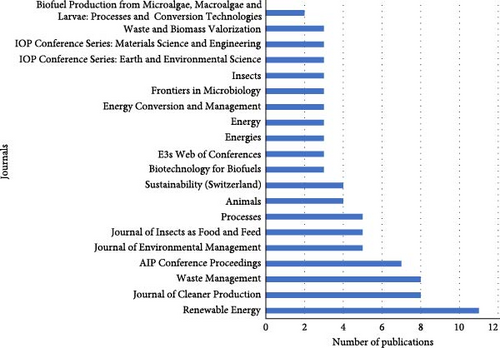
Figure 14 presents the most productive institutions based on the number of publications. It can be seen that Huazhong Agricultural University in China has the highest publication, with 112 articles. This is followed closely by Universiti Teknologi Petronas in Malaysia with 100 publications, suggesting that these two institutions are at the forefront of BSF larvae-based biofuel research. There is a significant drop to the third-ranked institution, the University of Basilicata in Italy, with 22 publications. This considerable gap highlights the concentrated nature of research in this field, with two institutions dominating the publication sector. The figure includes universities from various countries, including China, Malaysia, Italy, Taiwan, the Netherlands, Egypt, Austria, the United States, South Africa, Poland, Thailand, Belgium, and South Korea, indicating a global interest in this research area.
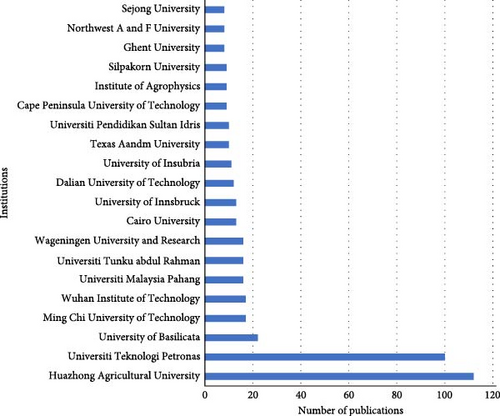
However, the distribution is notably skewed toward Asian institutions, particularly those in China and Malaysia. This geographical concentration may indicate regional priorities in alternative energy research, funding availability, or specific environmental challenges that make BSF larvae-based biofuel production particularly relevant. The diversity of institutions, ranging from agricultural universities to technology-focused institutions, suggests a multidisciplinary approach to this research, combining expertise in entomology, biotechnology, and energy engineering. The implications of these results are significant. They indicate potential hubs of knowledge and expertise in BSF larvae-based biofuel production, highlighting opportunities for international collaboration and suggesting where future breakthroughs might originate. The concentration of research in certain institutions also raises questions about the global distribution of resources and expertise in this emerging field and may point to the need for more widespread capacity building to ensure that the benefits of this technology can be realized on a global scale.
The citation map in Figure 15 reveals significant disparities in research output and impact across different countries. China has 2,080 citations, more than double that of the next highest country, indicating its dominant position in this field. The United States follows with 842 citations, showcasing its substantial contribution to the research. Malaysia, Italy, Belgium, and the Netherlands also demonstrate strong research output, with citations ranging from 571 to 759, suggesting these countries are key players in developing BSF larvae-based biofuel technologies. There is a notable drop in citations after the Netherlands, with Korea and Sweden receiving 177 citations, followed by India and Colombia with around 120 citations each. This pattern indicates a concentration of high-impact research in a handful of countries, primarily in Asia and Europe, with some representation from North and South America. The map shows limited contributions from African countries, with Kenya, Egypt, South Africa, and Nigeria appearing lower on the map. This geographical disparity in research output and impact could be attributed to funding availability, research infrastructure, and national renewable energy and waste management priorities. The result highlights the need for increased international collaboration to bridge the research gap between leading and lagging countries. Also, the concentration of research in certain regions may lead to context-specific solutions that may not be universally applicable, emphasizing the importance of diversifying research efforts. In addition, the high citation counts in countries like China and the USA suggest that their research findings and methodologies likely influence global approaches to using BSF larvae in biofuel production. Furthermore, the relatively low citation counts in many developing countries, particularly Africa, indicate an opportunity for knowledge transfer and capacity building to harness this technology in regions where sustainable waste management and alternative fuel sources could have significant economic and environmental impacts.
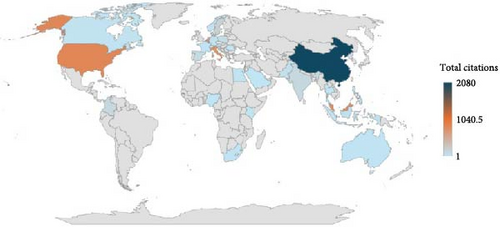
4.9. Recent Advances in Utilizing BSF Larvae in Biofuel Production
This section explores recent advancements in applying BSF larvae (H. illucens) in biofuel production. Studies by Tran et al. [78] and Kaczor et al. [79] provided comprehensive overviews of the potential applications of BSF larvae. These studies highlighted the insect’s versatility in biofuel production, waste management, chitin extraction, and environmental remediation. The wide range of BSF applications emphasizes its potential as a sustainable solution for various industries, particularly in the context of circular economy practices.
In view of this, several authors have highlighted the remarkable potential of BSF larvae in biodiesel production, showcasing their ability to convert organic waste into high-quality biofuel while addressing waste management challenges. For instance, Li et al. [38] focused on using BSF larvae to process dairy manure. The authors found that the larvae could yield 15.8 g of biodiesel from 70.8 g of dry larvae, with residual materials rich in sugars that could serve other applications. Further emphasizing this potential, Zheng et al. [80] assessed the larvae’s ability to process solid restaurant waste after grease extraction. The authors revealed that the BSF larvae reduced waste mass by 61.8% while producing biodiesel that meets European standards (EN 14214). Feng et al. [81] investigated and optimized a surfactant-assisted extraction method for lipids from wet BSF larvae biomass, focusing on various factors affecting the extraction process. The study achieved a high lipid extraction capacity of 78.99% under optimized conditions (using specific solvent-water ratios, biomass-solvent ratios, surfactant concentration, extraction time, and temperature), with saponifiable lipid purities exceeding 80% and minimal impact on lipid composition, demonstrating that surfactant-assisted extraction is a highly efficient technique for lipid extraction from BSF larvae biomass. Further emphasizing the effectiveness of BSF larvae, Ishak and Kamari [82] converted BSF lipids cultivated from kitchen waste into biodiesel. Their product met ASTM and European biodiesel standards, validating its quality and positioning it as an alternative to plant-based biofuels. The study of Park et al. [83] synthesized biodiesel from BSF larvae grown on food waste and evaluated its potential as a transportation fuel. Although the oxidation stability initially fell short of standards, the issue was resolved by adding antioxidants, highlighting the fuel’s potential viability for practical applications.
Likewise, Surendra et al. [84] investigated using BSF larvae to convert food waste into protein- and fat-rich prepupae. These larvae have high concentrations of medium-chain saturated fatty acids, making them suitable for high-quality biodiesel production. Their byproducts, such as pressed cake and meal, provide key alternatives to commercial animal feed, demonstrating the dual benefit of waste management and product generation. The work of [85] developed a coconversion process combining BSF larvae and microbes to convert rice straw and restaurant waste into larval grease for biodiesel. Their process efficiently digested cellulose and other components, producing biodiesel that met most European standards. This demonstrates the method’s viability as a low-cost alternative for biodiesel production from lignocellulosic material. Leong et al. [86], investigating lipid profiles from BSF larvae fed various organic substrates, confirm that lipid composition directly influences biodiesel quality. Fatty acids C12:0, C16:0, and C18:1n9c were most prevalent, with C12:0 being particularly dominant. The study emphasized that substrates significantly impact the larvae’s lipid profiles, critical to optimizing biodiesel production. Other significant contributions came from Nguyen et al. [87] and Liu et al. [88], who focused on the biochemical processes for optimizing biodiesel production from BSF larvae fats. Nguyen et al. [87] work involved using n-hexane as a cosolvent, achieving a 94.14% biodiesel yield. This process highlights cost-effective production possibilities.
Other notable studies focused on optimizing biodiesel production from BSF larvae through various methods. In view of this, Kumari et al. [89] optimized the production by identifying key factors such as methanol ratio and reaction time, achieving a high biodiesel yield of 96%. Their process demonstrated a clear pathway for producing eco-friendly biodiesel from larvae fed on agricultural residues. Similarly, Shanani et al. [90] assessed using a waste-derived catalyst for converting BSF maggot oil into biodiesel. The study found that the waste-derived zeolite catalyst significantly outperformed conventional catalysts in biodiesel yield, further improving the economic feasibility of biodiesel production from insect biomass. Wong et al. [91] evaluated the potential of BSF and weevil larvae for biodiesel production in Malaysia. The findings suggest that BSF larvae, with lipid content comparable to plant-based sources like coconut oil, offer a promising nonfood biodiesel feedstock, addressing concerns over the competition between food and fuel production. Almutairi et al. [92] evaluated a zero-waste approach for recycling byproducts from the rapeseed-based biodiesel industry (lipid-free rapeseed cake and waste glycerol) using BSF larvae. The result showed that supplementing 5% waste glycerol to rapeseed cake significantly enhanced BSF larvae growth, lipid content, and fatty acid methyl esters (FAMEs) productivity, resulting in biodiesel with higher cetane numbers compared to rapeseed biodiesel, demonstrating BSF larvae’s potential as a sustainable mini-livestock for biodiesel production through efficient byproduct recirculation.
Using a transesterification reaction, Leong and Kutty [73] investigated the influence of BSF fatty acid properties on biodiesel quality. The investigation revealed that the FAME produced from H. illucens biomass under optimum conditions met the EN 14214 and ASTM 6751 biodiesel standards for several important properties, including density, kinetic viscosity, copper strip corrosion, oxidation stability, and cloud points. Leong et al. [93] evaluated the interactions between variables (catalyst loading, reaction time, temperature, and methanol to sample mass ratio) in the synthesis of biodiesel from H. illucens prepupae fed with fruit waste and food waste, using response surface methodology (RSM) for optimization. The study achieved high biodiesel yields (96.15% from fruit waste-fed larvae and 94.63% from food waste-fed larvae) under optimized conditions, with the resulting FAME meeting EN 14214 and ASTM 6751 biodiesel standards, demonstrating the potential of H. illucens prepupae as a viable feedstock for biodiesel production.
Also, research into catalytic and enzymatic processes for converting BSF larvae into biodiesel has shown promising results. For example, Nguyen et al. [94] optimized a lipase-catalyzed transesterification process, achieving a 96.18% biodiesel yield. This enzymatic method is eco-friendly and sustainable, reducing the need for harsh chemical catalysts. Further improvements were made by Jung et al. [95], who introduced a noncatalytic transesterification process that converted BSF larvae into biodiesel in just 1 min at 390°C using a porous material. This innovative method reduces the energy and time needed for biodiesel production, making it a more commercially viable option. In the work of [96], the authors improved the fuel properties of BSF crude oil by blending it with diethyl ether, significantly reducing viscosity and increasing the cetane number. This blending approach shows promise for enhancing the performance of BSF oil as a biodiesel feedstock. Yusaf et al. [97] investigated the physical-chemical properties of fuel blends incorporating BSF larvae oil, finding that increasing the proportion of larvae oil significantly altered key fuel properties, such as viscosity and flash point, which are crucial for internal combustion engines.
In addition to their promising role in biodiesel production, BSF larvae have shown significant potential in biogas generation. For example, the study of Wee and Su [98] investigated a two-step biological treatment combining solid-state anaerobic digestion with BSF larvae composting. The authors suggested that this combination produces high methane yields while efficiently treating dairy cattle manure. Similarly, Wedwitschka et al. [99] explored the anaerobic digestion of insect frass, showing that BSF frass has methane yields comparable to cow and pig manure, commonly used for biogas production. Insect frass has been identified as a nutrient-rich substrate that eliminates the need for codigestion with other organic materials. In the work of [100], the authors measured the biogas and methane production efficiency of BSF larvae fed on food waste, achieving a biogas efficiency of 198.75 m3/Mg of fresh mass and methane concentrations of 64.27%. These results underline the larvae’s potential for directly contributing to anaerobic digestion for sustainable waste management and energy production. Li et al. [101] developed a two-step process to produce bioenergy from corncob waste. This process involved anaerobic digestion to produce biogas, followed by conversion of the residual biomass using BSF larvae to extract biodiesel. The study showed that BSF larvae could enhance grease accumulation and degrade lignocellulose effectively, illustrating a promising bioenergy production method. Abubakar et al. [21] assessed the potential of insects, including BSF, as a feedstock for biogas production. Their high protein and lipid content and the nutrient-rich insect frass enhance their viability as a sustainable biogas feedstock. Bulak et al. [102] further evaluated the methane production potential from insect breeding waste, including BSF. The study showed that insect waste has comparable biomethane potential to more commonly used substrates like cattle manure, further supporting the use of insects in anaerobic digestion processes for renewable energy generation. Additional research explored the enhancement of BSF-derived biofuels.
The ability of BSF larvae to convert various organic substrates into valuable byproducts like animal feed and fertilizers is well-established. Spranghers et al. [103] demonstrated the flexibility of BSF larvae, noting that the larvae’s nutrient profile varies based on the type of substrate fed, thereby allowing customized nutrient outputs for specific agricultural or industrial needs. Čičková et al. [48] supported this finding, emphasizing that larvae fed on nutrient-rich waste streams produce high-quality animal feed and byproducts like fertilizers. Despite their promise, these studies indicate challenges related to scaling up production, particularly in ensuring the biological consistency of the larvae. Pas et al. [104] contributed to understanding the digestate from anaerobic digestion processes, suggesting that BSF larvae could further process solid digestate to enhance its nutritional value. However, enzyme-treated digestate was found to be less effective than standard feed. This points to opportunities for optimizing pretreatment processes for improved outcomes. Mangindaan et al. [24] explored BSF larvae’s role in the waste-food-energy nexus, emphasizing that larvae can effectively convert waste into animal feed, biodiesel, and other products. The larvae’s ability to consume high amounts of organic waste within a short lifecycle makes them a promising solution for global waste challenges.
Despite the demonstrated success of BSF larvae in waste conversion and biofuel production, several challenges hinder large-scale implementation. Li et al. [105] highlighted issues in mass egg production and biological challenges related to ensuring the consistency of larvae yields across different organic waste streams. Čičková et al. [48] echoed these concerns, pointing out the need for technological innovations to address scaling issues. However, research by Sitepu [62] offers a potential solution through controllable crushing devices that optimize the direct transesterification process for biodiesel production. This method achieves high biodiesel conversion rates under relatively mild conditions, minimizing waste and solvent use. Similarly, He et al. [106] introduced a novel enzymatic transesterification method combining two lipase enzymes, yielding biodiesel that meets the EN14214 biodiesel standard. These studies highlight innovative approaches that could reduce production costs and enhance the scalability of BSF-based biodiesel production.
5. Summary and Prospects for Future Perspectives
This comprehensive review explores the potential of BSF larvae in biofuel production, particularly biodiesel and biogas, highlighting its role in sustainable waste management and circular economy practices. The keyword analysis reveals a strong focus on “biodiesel,” “black soldier fly,” and “hermetia illucens,” indicating the centrality of these concepts in the research. The thematic evolution shifts from an initial broad interest in BSF larvae for biofuel applications to more specific focuses on biodiesel production, waste management, and circular economy principles. The factorial analysis demonstrates a holistic research approach, covering the entire value chain from waste management to engine performance.
Recent advances in utilizing BSF larvae for biofuel production have shown promising results. Studies have demonstrated the efficiency of BSF larvae in converting various organic wastes into biodiesel. Optimization of biodiesel production processes, including waste-derived catalysts and zero-waste approaches, has led to high yields and improved biodiesel quality. The versatility of BSF larvae in converting different organic substrates into valuable byproducts like animal feed and fertilizers has also been established. In addition to biodiesel, BSF larvae have shown potential in biogas production. Studies have explored the use of BSF larvae in solid-state anaerobic digestion and the anaerobic digestion of insect frass, demonstrating high methane yields. Combining BSF larvae with other processes, such as anaerobic digestion, has shown promise in enhancing overall bioenergy production. Research has also focused on improving the properties of BSF-derived biofuels. Blending BSF crude oil with additives like diethyl ether has enhanced fuel properties. Innovative catalytic and enzymatic processes have been developed to improve the efficiency and sustainability of biodiesel production from BSF larvae.
Despite the demonstrated success, challenges remain in scaling up BSF larvae-based biofuel production. Issues such as mass egg production, ensuring consistency in larvae yields across different waste streams, and technological innovations for large-scale implementation must be addressed. Several promising future research directions can be proposed based on the current state of research. One key area that requires further exploration is determining optimal rearing conditions for BSF larvae across various waste streams. This will ensure consistent yields and high-quality larvae production. Researchers should focus on understanding how different environmental factors, such as temperature, humidity, and substrate composition, impact larval growth, development, and lipid accumulation, which are critical for biofuel production [107, 108]. Another important avenue for future research is the development of BSF strains with enhanced capabilities. Specifically, selective breeding or genetic engineering could be employed to improve lipid accumulation and waste conversion efficiency. Such advancements could significantly boost the potential for biofuel production from BSF larvae [109].
In addition, exploring the potential of integrating BSF larvae into biorefinery systems, where multiple valuable products such as biodiesel, biogas, animal feed, and chitin are produced simultaneously, could increase the economic feasibility and sustainability of the process [110]. Likewise, compared to conventional biofuel production methods, comprehensive life cycle assessments and techno-economic analyses are essential to evaluate BSF larvae-based biofuel production’s environmental impacts and economic viability. These analyses will help identify the most sustainable and cost-effective approaches for scaling up this technology [111]. Further research into innovative reactor designs, automated feeding systems, and harvesting technologies is crucial to facilitate the industrialization of BSF larvae-based biofuels. These advancements will help improve the efficiency and scalability of BSF larvae production processes [102].
Moreover, improving BSF larvae-derived biodiesel’s oxidative stability and cold flow properties is critical for enhancing its commercial viability. Research into using additives or blending strategies to achieve these improvements should be prioritized [105]. Investigating advanced conversion technologies, such as hydrothermal liquefaction or pyrolysis, for BSF larvae biomass could lead to higher-quality biofuels or enable the production of a broader range of bioenergy products, expanding the potential applications of BSF larvae-based biofuels [112]. Developing efficient pretreatment methods for complex organic wastes and exploring codigestion strategies with BSF larvae could further enhance waste conversion efficiency and biofuel yields [113]. It is also crucial to investigate the potential presence of contaminants or pathogens in BSF larvae-derived biofuels and to establish appropriate safety protocols to ensure product quality and safety for widespread adoption [37]. Researchers could focus on consumer acceptance of insect-derived biofuels and identify potential market barriers that will be vital for successfully commercializing BSF larvae-based biofuels. Therefore, understanding consumer perceptions and addressing these challenges will be key to unlocking the full potential of this promising biofuel source [114]. The scalability of BSF biofuel technologies depends on addressing public concerns over insect-derived products. Transparent guidelines, community engagement, and adherence to animal welfare standards are essential to gaining public trust and market acceptance.
Artificial intelligence (AI) is transforming the energy sector. Therefore, future studies on integrating AI can significantly enhance the efficiency and scalability of this process. AI systems can monitor and control key environmental parameters affecting BSF larvae growth and lipid accumulation in this context. Machine learning algorithms can analyze data from sensors tracking temperature, humidity, substrate composition, and larval density to maintain optimal conditions [115, 116]. Also, computer vision systems can assess larval development stages and health in real-time, enabling precise harvest timing [117]. Likewise, deep learning models can optimize the composition of organic waste substrates fed to the larvae [118]. AI can analyze the nutritional content of different waste streams and determine ideal mixing ratios to maximize lipid production. This ensures efficient conversion of waste materials while maintaining consistent biofuel feedstock quality. Industrial-scale BSF larvae biofuel production requires careful orchestration of multiple process steps. AI can coordinate substrate preparation, larval rearing, harvesting, and extraction operations.
These future research directions aim to address current challenges and unlock the full potential of BSF larvae in sustainable biofuel production, waste management, and circular economy practices. It is worth mentioning that researchers can contribute to the development of more efficient, economically viable, and environmentally friendly biofuel production systems based on BSF larvae by focusing on these areas.
6. Conclusion
This study comprehensively examines the potential of BSF larvae as a sustainable resource for biofuel production. By utilizing waste-to-energy strategies, BSF larvae demonstrate significant promise in addressing global challenges related to waste management, renewable energy generation, and the transition to circular economy principles. This study revealed notable advancements, including improved biodiesel yields, biogas production, and innovative catalytic and enzymatic processing methods. These developments highlight the feasibility of BSF larvae as a dual-purpose solution for organic waste valorization and biofuel production. The findings of this study have significant policy and practical implications, particularly for developing nations seeking sustainable energy solutions and effective waste management strategies. Policymakers should consider integrating BSF-based biofuel production into national renewable energy policies by establishing regulatory frameworks, incentivizing research, and promoting public–private partnerships to scale up production. Municipalities can incorporate BSF larvae into waste management systems to enhance organic waste valorization while reducing landfill emissions, aligning with climate mitigation commitments under the Paris Agreement. Moreover, decentralized BSF larvae biofuel units can provide energy access in rural and off-grid communities, fostering economic development and reducing reliance on fossil fuel imports. Capacity-building initiatives and technology transfer programs should be prioritized to equip stakeholders with the necessary knowledge and skills for efficient BSF cultivation and biofuel extraction. Furthermore, supporting multiproduct value chains that utilize BSF larvae for biofuel, animal feed, and fertilizer can enhance economic viability and resource efficiency. Developing nations can leverage BSF-based biofuels to achieve sustainable energy transitions while addressing pressing environmental challenges by adopting targeted policies and strategic investments. Policymakers, industry stakeholders, and researchers must collaborate to establish supportive frameworks enabling this innovative technology’s adoption at scale. Further research is essential to overcome the challenges highlighted in this review, particularly those associated with production scalability and biological consistency. Future studies should optimize larval rearing conditions, including substrate formulation, environmental controls, and genetic improvements to enhance lipid accumulation. Exploring integrated biorefinery models that simultaneously generate multiple high-value products can further elevate the economic feasibility of BSF-based systems. Additionally, life cycle assessments and techno-economic analyses are critical to comprehensively understanding the sustainability and cost-effectiveness of these systems compared to conventional biofuel technologies. Emerging conversion technologies such as hydrothermal liquefaction and pyrolysis warrant investigation to expand the range of bioenergy products derivable from BSF larvae. Addressing safety concerns, including potential contaminants in BSF-derived fuels, is crucial for regulatory approval and consumer acceptance. Moreover, research into public perceptions and market dynamics will aid in successfully commercializing BSF-based biofuels.
7. Limitations for Future Research
Despite the comprehensive nature of this review, certain limitations should be acknowledged. First, though the study employs a bibliometric and systematic review approach to analyze research trends in BSF larvae-based biofuel production, the reliance on the Scopus database may exclude relevant studies indexed in other databases such as Web of Science and PubMed. This may slightly limit the scope of the analyzed literature. Additionally, the study primarily focuses on published research articles, potentially overlooking industry reports, patents, and gray literature that may provide additional insights into technological advancements and commercialization efforts. Furthermore, although bibliometric analysis identifies global research trends, it does not detail large-scale BSF-based biofuel production’s technical feasibility and economic viability.
Ethics Statement
The authors have nothing to report.
Consent
The authors have nothing to report.
Conflicts of Interest
The authors declare no conflicts of interest.
Author Contributions
Conceptualization: Flavio Odoi-Yorke and Agnes Naa Abeley Abbey. Methodology: Flavio Odoi-Yorke, Agnes Naa Abeley Abbey, Kingsford Kweku Ansah, and Enoch Asante. Formal analysis and investigation: Kingsford Kweku Ansah, Gidphil Mensah, and Lawrence Atepor. Writing–original draft preparation: Flavio Odoi-Yorke, Agnes Naa Abeley Abbey, Enoch Asante, Kingsford Kweku Ansah, Daniel Baffour Asare, Gidphil Mensah, Eunice Akyereko Adjei, and Lawrence Atepor. Writing–review and editing: Flavio Odoi-Yorke, Agnes Naa Abeley Abbey, Enoch Asante, Kingsford Kweku Ansah, Daniel Baffour Asare, Gidphil Mensah, Eunice Akyereko Adjei, and Lawrence Atepor. Resources: Flavio Odoi-Yorke and Lawrence Atepor. Supervision: Flavio Odoi-Yorke, Agnes Naa Abeley Abbey, and Lawrence Atepor.
Funding
No funding was received for this research.
Acknowledgments
The authors acknowledge John Eshun Davis for proofreading the manuscript.
Open Research
Data Availability Statement
Data sharing is not applicable to this article as no new data were created or analyzed in this study.




